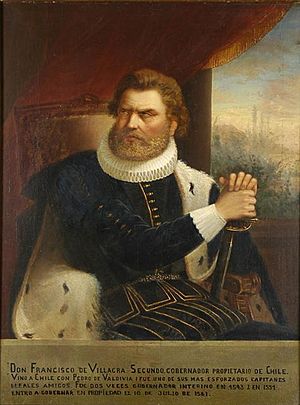Francisco de Villagra facts for kids
Quick facts for kids
Francisco de Villagra
|
|
|---|---|
 |
|
| Royal Governor of Chile | |
| In office 1547–1549 |
|
| Monarch | Charles V |
| Preceded by | Pedro de Valdivia |
| Succeeded by | Pedro de Valdivia |
| In office 1553–1557 |
|
| Monarch | Charles V Philip II |
| Preceded by | Pedro de Valdivia |
| Succeeded by | García Hurtado de Mendoza |
| In office 1561–1563 |
|
| Monarch | Philip II |
| Preceded by | García Hurtado de Mendoza |
| Succeeded by | Pedro de Villagra |
| Personal details | |
| Born | c. 1511 Santervás de Campos, Valladolid Province, Spain |
| Died | 22 July 1563 Concepción, Chile |
| Children | Pedro de Villagra, el mozo |
| Military service | |
| Allegiance | |
| Years of service | 1530s–1563 |
| Battles/wars | Conquest of Chile |
Francisco de Villagra Velázquez (born around 1511 – died July 22, 1563) was a Spanish explorer and soldier. He played an important role in the early history of Chile. He served three times as the governor of the region.
Contents
Early Life and Adventures
Francisco de Villagra was born around 1511 in Santervás de Campos, Spain. When he arrived in America, he went to Peru. He faced serious trouble there for trying to help Diego de Almagro, who was a prisoner. Luckily, his life was spared.
Exploring and Settling Chile
Villagra traveled to Chile with Pedro de Valdivia, another famous Spanish explorer. He helped in the early efforts to conquer and settle Chile. He was there when the city of Santiago was founded in 1541. Villagra held various important jobs in the city's government. He also helped defend Santiago from an attack by the local leader Michimalonco in September 1541.
First Time as Governor
In 1548, Valdivia decided to go to Peru to get more soldiers and supplies. He chose Villagra to be the temporary governor of Chile. Soon after taking charge, Villagra uncovered a plot by Pedro Sánchez de la Hoz. This man had tried to take control before. Villagra dealt with the situation firmly.
Later, in 1551, Villagra went to Peru himself. He helped recruit more men for future campaigns in the south against the Mapuches. He then returned to Chile to join these important missions.
Second Time as Governor
Pedro de Valdivia died in the Battle of Tucapel on December 25, 1553. In his will, Valdivia had named Jerónimo de Alderete as his first choice for governor. If Alderete couldn't do it, Francisco de Aguirre was the second choice, and Villagra was the third.
Alderete was in Spain at the time. Aguirre was busy exploring another area called Tucumán. So, the cities in the south of Chile chose Villagra as their governor. However, in Santiago, another leader named Rodrigo de Quiroga also claimed to be governor.
Villagra tried to stop a major rebellion by the native people, led by Lautaro. But in the Battle of Marihueñu on February 26, Villagra suffered a big defeat. Many of his soldiers were killed, and the city of Concepción was destroyed. When he returned to Santiago, he convinced Quiroga to step down.
Meanwhile, Aguirre heard the news in Tucumán. He believed he should be governor because Alderete had died and Villagra was the next choice. The situation caused tension, but it was eventually decided by a higher court in Lima. They ruled that Villagra would be the governor for a certain period.
The war against the Mapuches continued. Lautaro defeated the Spanish again in Angol and destroyed Concepción once more. However, Villagra's cousin, Pedro de Villagra, stopped Lautaro's advance towards Santiago at the Battle of Peteroa. Francisco de Villagra then marched south. He managed to strengthen the Spanish cities there. Later, he surprised and defeated the Mapuches, killing Lautaro, in the Battle of Mataquito.
Sent to Lima
Soon after Villagra's victory at Mataquito, a new governor arrived. This was Don García Hurtado de Mendoza, 5th Marquis of Cañete, the son of the viceroy. One of the new governor's first actions was to arrest both Aguirre and Villagra. They were sent to Lima to be judged. The decision was in Villagra's favor, and many people saw his arrest as unfair.
Final Time as Governor and Death
Years later, the King of Spain named Villagra as the new governor, replacing Hurtado de Mendoza. Villagra took office in 1561. His new term started with a terrible event: the ship he arrived on brought smallpox to Chile. This disease caused a terrible outbreak in Valparaíso and Santiago. It also severely affected the Mapuche people, with about 20 to 25 percent of their population dying.
As governor, Villagra changed the rules for working in the mines. He also took back land grants that the previous governor had given to his friends. This caused new protests against him. He organized another expedition against the Mapuche, but he became very ill from all the battles. He had to be carried on a stretcher to the battle sites. He also suffered the death of his son, Pedro de Villagra, el mozo, in this war. This made his health even worse. He then named his cousin, Pedro de Villagra, to continue the campaign and act as temporary governor.
Francisco de Villagra died in Concepción two days later, on July 22, 1563. He was buried as he wished, wearing the robes of a Franciscan monk.
See also
 In Spanish: Francisco de Villagra para niños
In Spanish: Francisco de Villagra para niños


